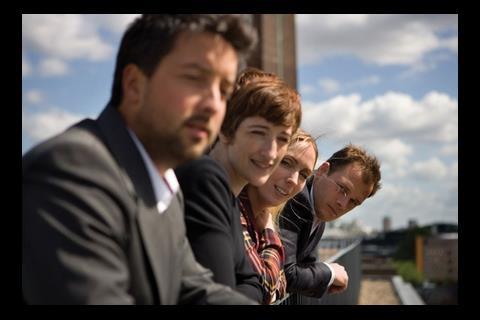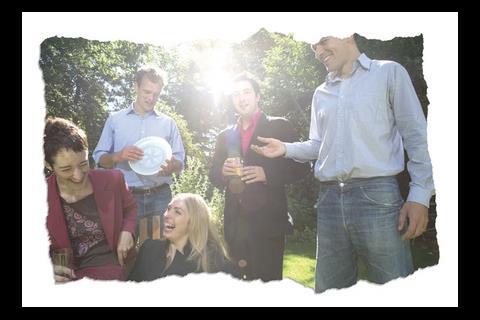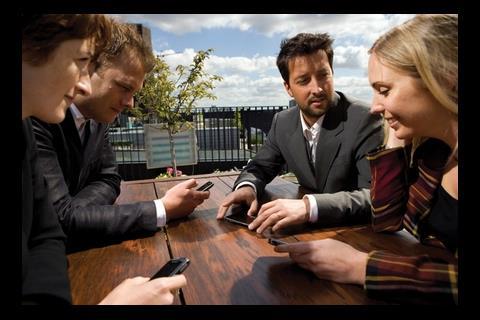Jacking in your job to set up a firm of your own is a dream shared by many architects, but few take the leap in their 20s. Back in 2006 we had a BBQ with some who did. Three years later, Emily Wright reunites them to find out what happened next
Three years ago, ║┌Č┤╔ńŪ° spent an idyllic afternoon with a group of young architects, some barbequed sausages and a Frisbee. The fivesome were able to take time out of their schedules for the summer rendezvous because they had all made the risky decision to build their practices up from scratch, and so were their own bosses.
Back then they told stories of stressful start-ups, first mistakes, and gorging a pay phone with 10p pieces to make the calls needed to win the first project.
Fast forward to June 2009 and things are very different. All the practices have operating phone systems for one thing, and the mood has dramatically shifted. Although the group (minus one half of Nick Cross Associates, who left to set up his own practice) is as upbeat as ever, summer games and the BBQ have been replaced with bleeping BlackBerries, diary co-ordination and scheduling meetings in the middle of the photoshoot.
And the hard work is clearly paying off as, despite some of the toughest market conditions the industry has ever seen, every one of these young firms is still up and running. In fact, all three are well positioned to grow through the recession and come out healthy on the other side ŌĆō a welcome antidote to the gloom shrouding the architecture sector.
Each of the practices has a story to tell about how they have kept their heads above water, from becoming world-renowned experts in bridge design to working on celebrity homes. But they all have one thing in common ŌĆō they are living, profit-making proof that with the right planning and some seriously long working days, you can make a success of setting up your own practice, no matter what the economic conditions. Here are those stories ŌĆ”
Pascale Scheurer and Holly Porter directors of Surface to Air
Having set up their practice in 2004 with no start-up cash, Scheurer and Porter were determined to keep their overheads low. Three years ago they were working closely with a business mentor to keep up to date on financial and marketing advice and were making good contacts with clients and within the RIBA.
What they did next
Scheurer and Porter have made a number of key decisions in the past three years, not least to focus on the education sector. ŌĆ£We slid in the door at the very last minute and became well established before every architect and his dog went for that work,ŌĆØ says Scheurer. Their other lucky break was joining forces with Pringle Brandon, the practice of Jack Pringle, the former RIBA president, who set up his own firm when he was 29. ŌĆ£We asked Jack to be our new business mentor two-and-a-half years ago. When he heard we wanted to focus on education, he said he wanted to get involved as he foresaw the rush for public work in the downturn,ŌĆØ says Scheurer. ŌĆ£So we set up a joint venture called Wired with his firm.ŌĆØ Surface to Air now operates out of a space in Pringle BrandonŌĆÖs offices.
Winning work
ŌĆ£WeŌĆÖre definitely punching above our weight ŌĆō advising on about ┬Ż2bn worth of schools projects,ŌĆØ says Scheurer. Surface to Air properly cracked the ║┌Č┤╔ńŪ° Schools for the Future (BSF) market in 2008 and is now working in all four major roles in the BSF programme: client design adviser to Camden and Hammersmith & Fulham, technical architect for Hounslow, design champion for major contractors, and architect for individual school projects. In addition, it has completed at least one project a year and its Rotunda Pupil Referral Unit was shortlisted for the BCSE Awards 2009 in the Best Extension or Refurbishment Category.
Running the business
Despite now winning good work, Scheurer and Porter keep costs as low as possible. Working out of a larger firmŌĆÖs office has been invaluable in keeping electricity, water and rent low. Scheurer says: ŌĆ£Later weŌĆÖll look to diversify, maybe into the commercial sector. But for at least the next two years itŌĆÖs education all the way.ŌĆØ
Personal challenges
The main change has been the birth of ScheurerŌĆÖs twin daughters. Both women admit that her being away from the office was tough, but Scheurer says it is doable with a good business partner, the right husband and an ability to multitask. ŌĆ£I learned how to bounce one baby, breastfeed the other and send an email all at the same time,ŌĆØ she says. Porter adds she was more than prepared to work the extra hours to keep the business ticking over in her partnerŌĆÖs absence. ŌĆ£ItŌĆÖs like a marriage,ŌĆØ she says. ŌĆ£You stick at things through thick and thin.ŌĆØ
Advice
You have to learn to say no, to be more selective and create your firmŌĆÖs ethos and specialism
Nick cross
ŌĆ£You need to be prepared for a new business to be tough for the first seven years at least,ŌĆØ says Porter. ŌĆ£And always use advisers. We still sit down with ours once every month or so.ŌĆØ She adds that once you are established you should remember two things. The first is making sure you listen: ŌĆ£Young architects can be so desperate to be heard, but donŌĆÖt let that be at the expense of what the client is telling you or asking for.ŌĆØ The second is to maintain good relationships: ŌĆ£You can lose a relationship with a client right up until the last day.ŌĆØ
The future
Thanks to meticulous budgeting for the past five years, Scheurer and Porter say they will be in a position to expand once the market has recovered. Both see the recession as an opportunity. ŌĆ£A lot of big practices today were grown through the last recession,ŌĆØ Porter says. ŌĆ£Good ideas can come out of being pushed right to the edge.ŌĆØ
Nick Cross director of Nick Cross Associates
He and business partner Max De Ros├®e set up the practice in 2004 with a ┬Ż15,000 overdraft. The pair started with an invoice of ┬Ż2,000 and a dog-sitting job on the side. They built up a turnover of ┬Ż100,000 in two years.
What he did next
De Ros├®e decided to leave the firm in January 2008 to set up his own firm, De Ros├®e Fa, with his wife. Cross says it was an amicable parting and that he gave De Ros├®e the clients and projects he was already working on to help him to get started. Since then, Cross has been picking up glamorous projects, mainly through personal recommendations.
Winning work and major projects
Both of CrossŌĆÖ key projects have been recent wins. The first is redesigning the house of Hollywood actress Gwyneth Paltrow and her musician husband Chris Martin. ŌĆ£I went shopping for the day with Gwyneth for stuff for the house,ŌĆØ says Cross. ŌĆ£It was the most surreal experience.ŌĆØ In the past month Cross has also been in talks about designing allotments for the former Candy & Candy project at Noho Square in the West End: ŌĆ£WeŌĆÖre calling it Growho,ŌĆØ he says.
Running the business
ŌĆ£IŌĆÖm more regimented these days,ŌĆØ says Cross who admitted back in 2006 that he and De Ros├®e had not set up their practice with a solid plan in place. He adds that he has had to become more efficient, especially since the departure of his business partner. As part of this drive, Cross hired a project manager six months ago: ŌĆ£Now weŌĆÖre getting bigger jobs, itŌĆÖs great to have someone who can work out the cost implications of design options, which is what the client wants, and needs, to know.ŌĆØ
Personal challenges
Balancing his career and children has been hard for Cross: ŌĆ£There is a huge tear between not being able to spend as much time out networking and absolutely having to win work as you have hungry mouths to feed,ŌĆØ he says. ŌĆ£I used to go to lots of events. I canŌĆÖt do that now with the kidsŌĆØ
Advice
For Cross, not taking on more than you can cope with has been a recipe for success: ŌĆ£I have learned to say no to some projects to avoid being overstretched,ŌĆØ he says. ŌĆ£In the old days I would gleefully agree to do any old loft conversion, but you have to be more selective and create your firmŌĆÖs ethos and specialism. But for the best advice I would listen to Pascale! She and Holly seem to be permanently 10 steps ahead of the game.ŌĆØ
The future
I learned how to bounce one baby, breastfeed the other and send an email all at the same time
Pascale Scheurer
ŌĆ£IŌĆÖd like to diversify and am looking at some new-build projects.ŌĆØ
Julian Hakes director of Hakes Associates, the firm he runs with his wife Cari-Jane
Julian and his wife had set up their firm when they were both 24 in 1995 after Julian won a competition when he was 22 and used the money for start-up capital. The firm always had a clear plan and was focused on the public health sector and international bridge design. Three years ago the practice was turning over ┬Ż600k a year.
What he did next
Three years ago the firm started to make inroads into the bridge market abroad and won a big scheme in Dubai. Hakes then went out to work on a project in Los Angeles, beating well-known firms such as Wilkinson Eyre, Make Architects, Adjaye Associates and Buro Happold. The firm is now involved in, or looking at schemes in Jordan, Saudi Arabia, Moscow and London.
Winning work and major projects
Since 2007, Hakes Associates has designed bridges in Los Angeles, Moscow and the Middle East. Other wins include the Liverpool Media Wall for Land Securities, Flint Facade department store in Colchester, Paddington Bridge and the Harbour Masters building in Paddington, Ribbon Bridge in Colchester, Southall Eel Net Bridge and a ┬Ż65m mixed retail scheme in central London.
Running the business
Hakes has resisted growing ŌĆō not easy when everyone around him was doing just that. He says keeping things small means the group is in a good position to increase staff when the market recovers. His main investment has been in technology. ŌĆ£Some new firms would start with the cheapest computers and equipment,ŌĆØ he says. ŌĆ£We went for the best we could afford and I think they have all paid for themselves already.ŌĆØ He adds that any spare funds went back into the company and that neither he, nor his wife paid themselves for 18 months.
Personal challenges
Apart from the severe knock of losing a major client and 80% of his work at start of year two, Hakes says having children affected the way the pair coped with the business: ŌĆ£You have to survive on less sleep, and balance work and home. The dynamic changed. But we clearly forgot about all of that because then we went and made another one.ŌĆØ
Advice
ŌĆ£If you are working abroad, you have to be where the project is all the time or risk losing the work. When I was looking at projects in Los Angeles, I know that between the time I left and the time I touched back down in the UK a local firm had already tried to pick up some of our work.ŌĆØ
The future
Hakes says the firm have several major bridge schemes in the pipeline and that he and his wife have also started working on more unusual ventures including jewellery, shoe and surfboard design.
Original print headline - Young, gifted and back
Then and now: Pascale

Pascale
Age 34
Children
None before. Now, one-year-old twin daughters, Carmen and Anais.
Car
An old, trusty bicycle ŌĆō no change there.
Phone
Then I had an ugly but indestructible green-screen beast by Motorola. Now I have a baby-proof BlackBerry Pearl.
Typical Saturday night
Three years ago these were spent hardcore clubbing. Now itŌĆÖs staying in, watching comedy and tucking the kids in.
Typical working week
Back then I would say my working hours were about 25 a day, eight days a week. Now I do less, although curiously, it was easy to go back to full-time work after having the twins. IŌĆÖm just more efficient now and tend not to work evenings or weekends.
Turnover
WeŌĆÖve doubled year on year and this looks set to continue for the foreseeable future.
Then and now: Holly

Holly
Age 30
Car
Then it was a VW Polo; now itŌĆÖs a Mini Cooper.
Phone
Three years ago I had a battered flip-top Samsung that had been dropped, pummelled and scratched beyond recognition. These days I have a BlackBerry that I wouldnŌĆÖt swap for anything ŌĆō except perhaps an iPhone.
Watch worn
Then, a Gucci slimline silver watch; now I have one by Georg Jensen. I love the simplicity of his designs.
Typical Saturday night
These used to revolve around champagne, Shoreditch and warehouse parties. Now, dinner overlooking the sea ŌĆō either here in the UK or Palma, Majorca, where I go every eight weeks.
Typical working week
I have always worked long hours ŌĆō though they are more regular now than they were three years ago.
Then and now: Nick

Nick
Age 34
Children
I now have Monty, two, and Frederick, three weeks.
Area of London lived in
Three years ago I was in Marylebone; now we live in Dulwich.
Car owned
I had a bicycle and now have a Volvo V70 Estate and BMW C1 moped.
Phone
My last phone was an old Sony Ericsson. Now I have an iPhone ŌĆō but only because it was free. Only Julian knows how to actually work one, as far as I can tell.
Career low point
Then it was working for a builder who did a runner; the career low light in the past 12 months was banking with NatWest.
Typical Saturday night
I canŌĆÖt remember what a Saturday night before the children was like. Now itŌĆÖs spent turning down the baby monitor and hoping my wife wonŌĆÖt notice.
Company turnover
Three years ago we were turning over ┬Ż150k, now its ┬Ż350k.
Then and now: Julian

Julian
Age 36
Children
I now have two boys aged five and three.
Area of London
Our first office was in the West End; then we moved into a warehouse in Bermondsey that we fitted out.
Car owned
Then I had a bike. When my boys arrived, I bought my first car. ItŌĆÖs a pre-war designed Black 1954 Ford. It was the same model of car I came back from hospital in when I was born.
Phone model
Three years ago I had an early smart phone. Now I have an iPhone. ItŌĆÖs also a mobile portfolio of current work.
Typical working week
In the early years we worked all weekends and very late into the evenings. We realised that this in not sustainable and now rarely work weekends. Occasionally work flow demands we work late.































1 Readers' comment